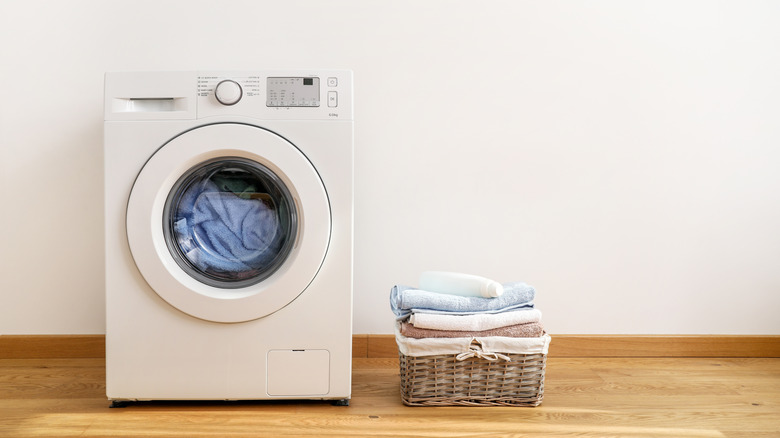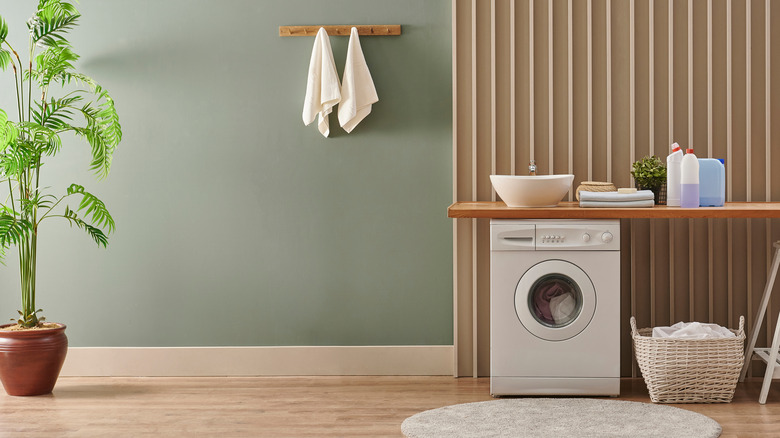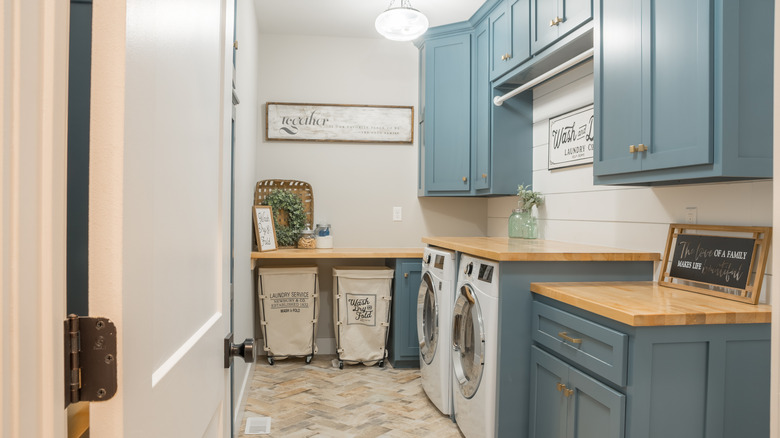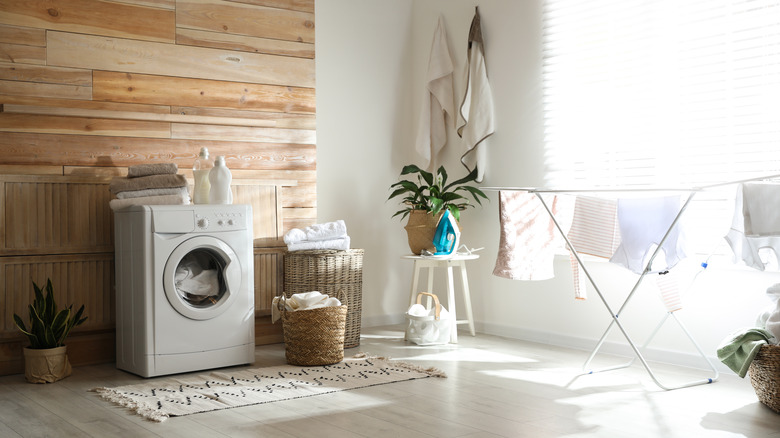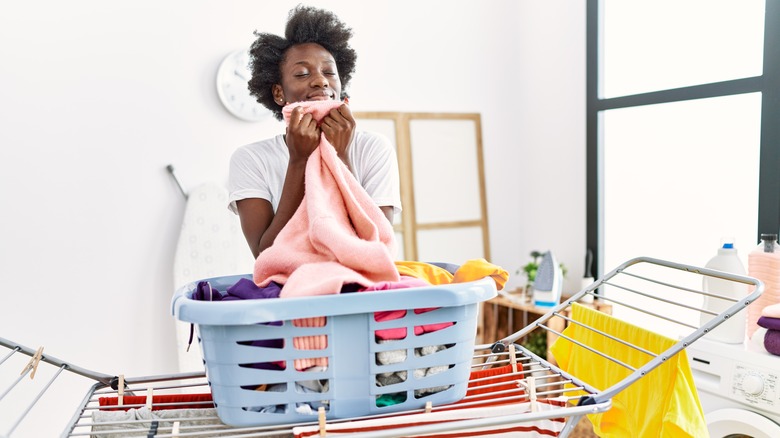How Much Does It Cost To Build A Laundry Room From Scratch?
Building a laundry room in your home provides a dedicated space to section off your textile washing operations. Laundry facilities are loud, they can be smelly, and oftentimes, homeowners find the laundry basket, necessary cleaning supplies, and the appliances themselves a significant burden on the space of another room.
Many homes feature laundry facilities in a bathroom or in the kitchen. This takes away from crucial space that could be used for other purposes and adds unneeded clutter to the area. So, making the change to a dedicated laundry room space can free up necessary storage and functional areas elsewhere, creating a welcome change in many homes. To construct a laundry room, you'll need to first identify an area that can facilitate the addition.
For example, in many properties, converting an entry hallway into a hybrid space that contains both a mudroom and laundry room can successfully serve the family's interests. You'll also need to move or replace your washing machine and dryer. Lastly, adding cabinets and countertops and evaluating the flooring (and perhaps making a necessary alteration here as well) round out the major features of a laundry room build. Angi estimates that a standard laundry room addition costs about $8,100, but this can be as low as $1,300 for minor alterations to an existing space or as much as $15,000 for a more complex and totally customized creation.
Factors for cost
Building a new laundry room requires a few key approaches. From site selection within your home's floor plan to introducing key features, the basic fabrication of laundry facilities revolves around walling off the room, installing appliances, and adding storage, shelving, and countertops.
Enclosing the space
The first aspect of any laundry room creation is the walling off of space. Drywall and basic stud layouts are essential for sectioning off this home area from surrounding elements. Whether you're taking space from the garage or another room in the house or adding a dedicated laundry room segment to the basement, finishing the walls is the first step to building this new space.
HomeAdvisor estimates that building framing and adding drywall costs between $20 and $39 per linear foot, with panels themselves running anywhere from $12 to $90 each. Costs can vary across local marketplaces and depending on the thickness, sizing, and other features that your particular build requires.
The basic framework will allow the space to take shape, but don't forget about cutouts and wiring that must go behind and through the drywall panels.
Adding flooring
Flooring is another key feature of the laundry room. In any part of the home, you'll want to add specialized flooring that fits in with the aesthetic and functionality of the area. In addition, the laundry room requires a particular type to provide long-term viability. Angi estimates that flooring for a laundry room typically costs between $280 and $840, with an additional $155 to $495 to accommodate subflooring preparation and installation needs.
Vinyl or tile are the best options in this space because they resist the high-intensity moisture that will be present in this part of the home (via Home Decor Bliss). Dryers create humidity as a rule, and the damp clothing that will often take up residence in the laundry room further contributes to the general need to protect the space against the worst aspects of standing moisture.
Cabinets and countertops
Laundry rooms provide functionality by incorporating cabinets and counter space alongside the appliances that will live there. Unlike a bathroom or kitchen-based laundry area, the laundry room provides a dedicated workspace and storage spaces for the needs and tasks of the laundry cycle.
Angi estimates that countertops will cost between $300 and $1,400 for a standard laundry room setup, while cabinets can range between $250 and $2,000, depending on the style and level of customization that you select for the furnishings that will adorn the room.
Appliances
Homeowners in the process of building a new laundry room might opt to replace their existing appliances. The primary features of the laundry space are the washing machine and dryer, costing between $250 and $2,050 and $200 and $1,750 on average, respectively (via Kitchens.com). During the remodel, you may consider installing new appliances to cut down on the electrical or water costs to run the machines. High-efficiency appliances will cost a little more upfront than other models, but they will pay you back over time with a lower drain on your utility bills for the following years you operate them.
Similarly, when building a new laundry room, you will want to measure out the dimensions of the machines you want to include in the finished product. Your new space may easily accommodate a much larger appliance footprint, leading to less washing and effort overall on your part. Making this change can benefit you in multiple ways.
Additional costs
In addition to the basic footprint of the laundry room, you will need to consider some additional features that can add to the price of the renovation opportunity.
Hookup of services
First and foremost, whether you're planning to move existing appliances or install new ones, you'll need to hook in water hoses, power, and exhaust features. These appliances are complex machines, and installing any type of washer and dryer will take a careful approach.
Homeowners themselves can handle the ventilation and other aspects of the final assemblage. Still, if you're unsure of the proper procedure here, it's best to leave this step to the contractor working on your renovation. Contractors are often more than capable of this task, but an alternative is to use an installation technician provided by the department store or outlet where you plan to buy new devices from. You might even get a free installation alongside the purchase if you find a deal or negotiate well enough.
Upgraded materials and custom cabinetry
Fixr estimates that stock cabinetry will cost between $100 and $300 per linear foot while custom installations rise to a cost between $500 and $1,500 per linear foot. Upgrading certain aspects of the build can give you a more bespoke look and feel, but for the privilege, you'll pay an additional cost for more robust or luxurious materials. You may even incur additional labor costs as a result of specialized handling needs or a longer time for the overall installation of your selected features.
As with any other part of the build, speaking with your contractor about pricing and maintaining a meeting of the minds throughout the renovation will help you and the team working on your home remain transparent about expectations and pricing at all times.
Mudroom and storage inclusions
Adding space for mudroom features can raise the cost of the project as well. If you're placing the laundry room in an area of the home that can facilitate the addition of mudroom features, you may want to build the space to a slightly larger specification. This will naturally boost the price due to the larger walling requirements, longer cabinetry installation, and expanded cabinet footprint.
The larger the room is, the more expensive the build will be — even before taking into consideration the added cost of mudroom-specific storage and bench space. Yet pairing these two features of the modern home together can enhance the utility of the addition and make for a more relaxing home. It's worth considering this matchup and evaluating your budget in order to make the best decision for your family and property. Mudrooms and laundry rooms are typically sized around the same basic dimensions — 5 feet long and 5 feet wide — as Homes & Gardens notes, so incorporating both features into one room will likely only require slightly bloating the floor plan to accommodate the dual-purpose.
Labor costs
Constructing a laundry room in your home will come with labor costs as well as the typical prices for materials and appliances that will adorn the room. Angi estimates that contractors will likely charge between $200 and $350 per hour for the construction of a new laundry room, depending on the difficulty and scope of the task.
This pricing also takes into account the number of additional people that will be working on the project. The more hands that are involved in the fabrication of your laundry room, the more expensive you can expect the build to be.
Why you need to build a dedicated laundry room
Building a new laundry room gives you access to a new way of living. The addition removes laundry clutter from a more heavily foot-trafficked area of the home and can revolutionize the way you experience and enjoy your place as a result.
This change reimagines the home layout
Building a laundry room can provide an immediate boost to the layout and functionality of your home. Instead of tripping over your laundry facilities while working on other tasks in the house, this addition segments the laundry appliances away from other areas, easing spatial constraints on your day-to-day life.
Adding a laundry room can provide a better overall footprint for the home, as well. If you are adding space to the residence (rather than repurposing interior space that already exists), some more square footage can go a long way to expanding both the physical dimensions of the home and the feeling of openness that you enjoy.
Laundry room space keeps this task separate from the main elements of the house
Separating laundry facilities and the rest of your home can immediately impact the relaxation factor you experience on the property. The ability to shut the door on your laundry needs is a powerful facet of this extra room (via Sea Pointe Design & Remodel).
For those working from home, for instance, closing off the laundry area rather than trudging through unwashed clothing during each trip to the kitchen for a new coffee or each bathroom visit can significantly hamper productivity. In addition, the need to finish off the next load of washing — and then fold it and start over again — can impact your level of focus, taking you away from the essential tasks of the day.
Similarly, in the evenings, you can close off the laundry space from the main living areas while relaxing with loved ones or as a means of keeping the home clean and tidy while hosting friends.
Benefits of a separated laundry room space
The benefits of a new laundry room are widespread. From added value in the home's financial underpinnings to a more relaxed lifestyle, making this change bleeds over into many aspects of life that have nothing to do with washing your clothing.
Added energy efficiency filters into other aspects of life
Energy efficiency upgrades are a key feature of modern homes. This changeover can be seen in the laundry room and many other home life aspects. Energy-efficient machines make a huge difference in the overall cost of operation, with total usage of half the water of a non-rated appliance and 30% less in electricity draw, according to Energy Savings.
Over the course of a single year, these savings can really add up, and the figure becomes even starker when considering the long lifespan of these appliances — 10 to 13 years on average, according to This Old House. Energy efficiency is becoming a currency of its own these days, as well. Homeowners are doing their part for the environment and their community by investing in appliances and home goods that take a smaller toll. By reducing your electrical and water bills, not only are you saving money for yourself and your household, you can be a part of the change that's making a difference for the planet by reducing the burden of high-intensity electricity production.
Easier laundry tasks improve peace of mind
The task of doing laundry can be hectic and time-consuming at the best of times. In addition, homeowners who don't have the luxury of a dedicated laundry room space have to work around spatial restrictions that place other needs ahead of the laundry tasks, making the chore even more of a burden. However, Craftsman Built notes that a laundry room serves as a consistent asset for homeowners because it changes the calculation of the facility space in your property.
Instead of sharing functional space with the kitchen or another area of the home, a laundry room allows you to organize washing loads, fold clothing, and store essential products and goods in a confined area for easy access and enhanced utility.
Improved resale value takes center stage for those thinking of selling
As with many other home improvement projects, centering on renovations that bring great resale value to the table is essential. For example, building a new laundry room not only helps you focus your attention on aspects of the house that are most important to your daily routine, but this addition can improve the resale value of your property significantly, according to Real Homes.
Focusing on financial value during a renovation project can help you highlight aspects of the residence that perform well when it comes time to sell the house. Everyone will move on at some point — whether you're thinking of relocating in the near future or plan to remain in the home your whole life and then leave the place to your children. Taking steps to ensure that your home's value is moving in the direction that supports your ongoing and future financial goals and needs is an essential component of homeownership. Renovating the laundry room, or adding an entirely new one, serves this purpose, and makes for a highly versatile addition.
